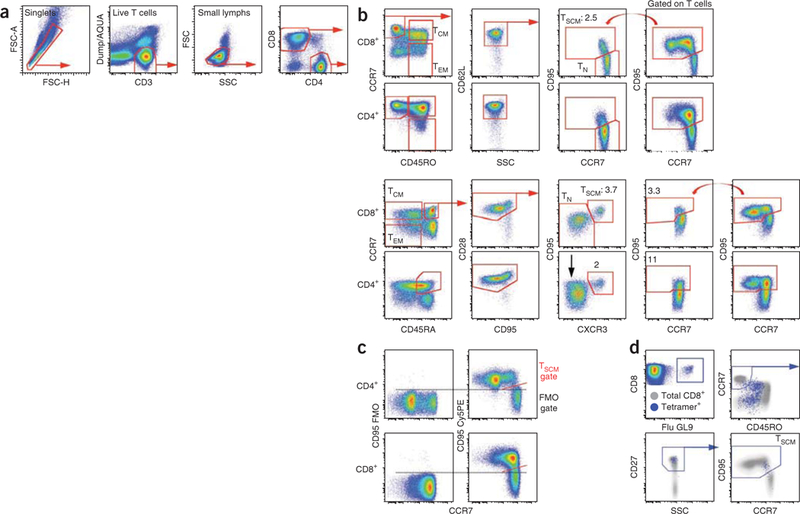Figure 1|.

Gating strategy for the identification of human and rhesus TSCM cells. (a,b) Human and NHP PBMCs were stained as indicated in Table 1. In this example, both panels included anti-CD4 conjugated to Qdot 585 in addition to anti-CD8 conjugated to Pacific Blue in order to allow the simultaneous identification of CD4+ and CD8+ T cells. These T cells were identified by first gating on singlets (FSC-H versus FSC-A), live CD3+ T cells (CD3 versus Dump/AQUA ) and lymphocytes (SSC versus FSC). Naive-like T cells were defined as CD45RO–CCR7+ CD62L+ in humans and as CD45RA+ CCR7+ CD28+ in rhesus macaques. In these gated populations, TSCM cells express CD95, whereas TN cells are CD95–. In NHP CD8+ T cells, CXCR3 is coexpressed with CD95 and thus helps identify CD8+ TSCM cells but not CD4 + TSCM cells, as not all CD95+ TSCM in naive-like CD4+ cells express CXCR3+ (black arrow). Red straight arrows indicate the sequential gating strategy. The curved red arrows indicate the gate to be copied on gated ‘naive-like’ cells. (c) CD95 FMO control in human T cells. Dashed bars indicate the threshold for positivity for CD95 expression, whereas the diagonal red bar indicates the TSCM gate. (d) Identification of human antigen–specific TSCM cells. Human PBMCs were stained as indicated in Table 1. CD8+ T cells were identified as in a. T cells specific for the influenza matrix protein58–66 (Flu GL9) were identified using an MHC class I tetramer (blue dots overlaid on total CD8+ T cells in gray). In this case, frozen PBMCs were used, and CD27 replaced CD62L for the identification of TSCM cells. Blue straight arrows indicate the sequential gating strategy. FSC, forward scatter; SSC, side scatter.
